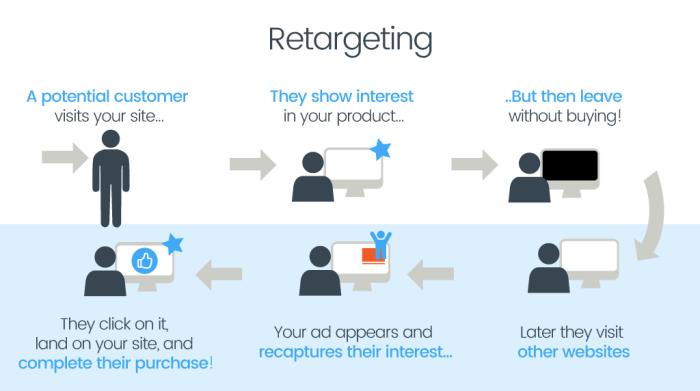Retargeting Ads Guide dives into the world of targeted advertising, revealing the secrets behind successful campaigns and strategies. Get ready to revolutionize your digital marketing game!
From defining retargeting ads to setting up campaigns and choosing the right platform, this guide has got you covered with all the essential information you need to know.
Introduction to Retargeting Ads: Retargeting Ads Guide

Retargeting ads are a powerful digital marketing strategy that involves targeting ads to users who have previously interacted with your website or products. These ads work by using cookies to track users’ online behavior and then displaying targeted ads to them as they browse the web.
Retargeting ads are crucial in digital marketing as they help businesses stay top-of-mind with potential customers, increase brand awareness, and drive conversions. By reaching out to users who have shown interest in your products or services, retargeting ads can significantly improve ROI and overall marketing effectiveness.
Examples of Successful Retargeting Ad Campaigns
- Amazon: Amazon uses retargeting ads to show products that users have viewed on their website but haven’t purchased. This serves as a reminder to users and encourages them to complete their purchase.
- Netflix: Netflix uses retargeting ads to promote new shows or movies to users who have previously watched similar content on the platform. This personalized approach increases the likelihood of users engaging with the ad.
- Zappos: Zappos uses retargeting ads to show users products they have added to their cart but haven’t purchased yet. This gentle nudge reminds users of items they were interested in and encourages them to make a purchase.
Types of Retargeting Ads

When it comes to retargeting ads, there are several types that marketers can utilize to reach their target audience effectively. Each type has its own unique approach and benefits, catering to different industries and customer behaviors.
Pixel-Based Retargeting Ads
Pixel-based retargeting ads involve placing a tracking pixel on your website, which then tracks visitors as they browse the web. This type of retargeting allows you to display ads to users who have visited your site but did not complete a desired action, such as making a purchase. Pixel-based retargeting is effective for e-commerce businesses, travel agencies, and subscription services.
List-Based Retargeting Ads
List-based retargeting ads involve uploading a list of customer data, such as email addresses or phone numbers, to a retargeting platform. The platform then matches this data to online users and displays ads to those individuals. This type of retargeting is beneficial for businesses with existing customer databases, such as CRM platforms, and can be highly effective for industries like B2B services, real estate, and financial services.
Dynamic Retargeting Ads
Dynamic retargeting ads personalize the ad content based on the user’s behavior on your website. These ads display products or services that the user has shown interest in, creating a more personalized experience. Dynamic retargeting is ideal for online retailers, travel websites, and automotive dealerships.
Social Media Retargeting Ads
Social media retargeting ads target users who have engaged with your brand on social media platforms like Facebook, Instagram, or LinkedIn. These ads can be highly effective in reaching a broader audience and driving engagement. Social media retargeting is particularly useful for industries like fashion, beauty, and lifestyle brands.
Video Retargeting Ads
Video retargeting ads involve displaying video ads to users who have interacted with your brand’s video content. These ads can help reinforce brand messaging and drive conversions. Video retargeting is popular among industries like entertainment, fitness, and technology companies.
Setting Up Retargeting Ads
Setting up a retargeting ad campaign involves a series of steps to ensure that your ads reach the right audience at the right time. Let’s dive into the process and best practices for creating effective retargeting ads.
Creating a Retargeting Ad Campaign, Retargeting Ads Guide
To set up a retargeting ad campaign, follow these steps:
- Choose a retargeting platform: Select a platform like Google Ads, Facebook Ads, or AdRoll to run your retargeting ads.
- Install a tracking pixel: Place a tracking pixel on your website to track visitors and their behavior.
- Create audience segments: Segment your audience based on their interactions with your site to deliver personalized ads.
- Design ad creatives: Develop visually appealing ad creatives that resonate with your audience and align with your brand.
- Set up retargeting rules: Define rules for when and how your ads will be displayed to users who have interacted with your site.
- Monitor and optimize: Continuously monitor the performance of your retargeting ads and make adjustments to improve results.
Best Practices for Retargeting Ad Content
When creating retargeting ad content, keep these best practices in mind:
- Personalize your ads: Tailor your ads to specific audience segments for better engagement.
- Use compelling visuals: Grab the attention of users with eye-catching images or videos in your ads.
- Create a sense of urgency: Include limited-time offers or promotions to encourage action from users.
- Provide clear call-to-actions: Direct users on what action to take next, whether it’s making a purchase or signing up.
- A/B test your ads: Experiment with different ad copies, visuals, and CTAs to identify what resonates best with your audience.
Segmenting Audiences for Effective Retargeting
To segment your audiences effectively for retargeting, consider the following:
- Behavioral segmentation: Target users based on their past interactions with your website, such as pages visited or products viewed.
- Demographic segmentation: Divide your audience by demographics like age, gender, or location to deliver more relevant ads.
- Psychographic segmentation: Understand the interests, values, and attitudes of your audience to personalize your retargeting efforts.
- CRM data segmentation: Utilize customer relationship management data to target users who have engaged with your brand before.
Retargeting Ad Platforms
When it comes to retargeting ad platforms, there are several popular options to choose from, including Google Ads, Facebook Ads, and AdRoll. Each platform comes with its own set of features and benefits, so it’s essential to understand the differences to choose the right one for your specific business goals.
Google Ads
Google Ads, formerly known as Google AdWords, is one of the most widely used advertising platforms on the web. It offers a variety of retargeting options, including display ads, search ads, and video ads. With Google Ads, you can reach a massive audience across the Google Display Network and Google Search Network. The platform provides robust targeting options, detailed analytics, and the ability to track conversions effectively.
Facebook Ads
Facebook Ads is another powerful platform for retargeting campaigns, especially for companies looking to target a specific audience based on their interests, demographics, and online behavior. With Facebook Ads, you can create engaging ad formats like carousel ads, slideshow ads, and video ads. The platform also offers advanced targeting features, such as lookalike audiences and custom audiences, to help you reach the right customers at the right time.
AdRoll
AdRoll is a popular retargeting platform that specializes in cross-device retargeting, allowing you to reach users across multiple devices and platforms. The platform offers dynamic ad creation, advanced audience segmentation, and detailed reporting tools to optimize your retargeting campaigns effectively. AdRoll integrates with various ad networks and social media platforms, making it a versatile option for businesses looking to expand their reach.
Choosing the Right Platform
When selecting a retargeting ad platform for your business, consider your specific goals and target audience. If you’re looking to reach a broad audience with diverse interests, Google Ads may be the right choice. For businesses focused on targeting specific demographics and interests, Facebook Ads could be more effective. And if you need advanced cross-device retargeting capabilities, AdRoll might be the best option. Evaluate the features, pricing, and targeting options of each platform to determine which one aligns best with your retargeting objectives.